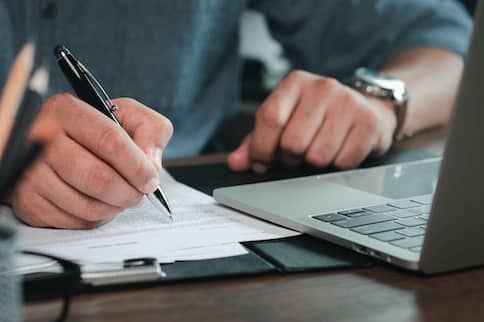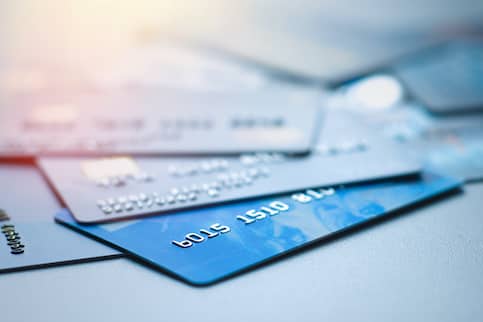How To Get Out Of Debt: A Complete Guide

Wondering how to get out of debt? You’re not alone. In 2021, the average American household carried around $96,371 in outstanding balances, according to ExperianTM. Thankfully for those looking to reduce debt, there’s hope yet.
While inflation remains a persistent concern, and the cost of many common household goods is still on the rise, there are still ways to eliminate debt and reduce your monthly payments and out-of-pocket expenses while giving your wallet more room to breathe. What’s more, reducing debt is often an especially important and practical step for anyone looking to purchase a new home soon. That’s because reducing debt can often help you secure more financing and on generally better terms.
What Is Debt?
Debt is money that you owe and are obligated to pay back to other parties, including but not limited to banks, credit unions and other financial institutions. From home mortgages to student loans, personal loans and credit cards, debt can come in many forms as you rack up expenses.
To some extent, it’s good to have debt — it can help you establish a credit history and credit mix, build your credit score, and demonstrate that you’re a responsible borrower and a safe bet in terms of lending money to. However, some forms of debt can impact a mortgage application more than others, making it more complicated and/or difficult to buy a home. For example, auto loans, child support payments, alimony and home equity loans can all influence your debt-to-income (DTI) ratio, which needs to be below a certain threshold to secure mortgage lending approval.
See What You Qualify For
Home Purchase
Home Refinance
Tap Into Equity
Credit Card Debt
Groceries, diapers, clothes, toys … life’s little expenses often add up, while paychecks generally tend to come too infrequently. This can lead many people to pay for items on credit. When you use a credit card to cover expenses that you don’t have the money for at the moment, you add to your credit card debt. Using your credit card regularly can help you build up your credit score and your credit history, making it easier to secure loans of various kinds. But this associated debt can also amass quickly if you don’t pay it back right away, and often comes with high interest rates attached. This can make it harder to pay down once the debt and interest are piled.
Student Loan Debt
Student loan debt starts to accrue when you take out a loan for education, such as to attend undergraduate studies at your preferred college or pursue a graduate or post-doctoral degree. It’s not cheap to pay for learning these days, nor is it often easy to manage the cost of room and board, books and school supplies on top of tuition. Often, people begin paying off student loan debt, with interest, once they graduate and will typically pay it for years and years.
Real Estate Debt
Ever bought an apartment, home, or condo without paying cash? Instead, you took out a home mortgage to finance the purchase? Then you’re likely familiar with the concept of real estate debt, which borrowers take on to help cover purchase costs of a home. Keep in mind that homeowners and investors alike often carry real estate debt for strategic reasons as well as financial ones. For instance, sometimes interest rates are low enough that it makes sense to borrow money at minimal cost to fund a home purchase, rather than tie up your own money.
Take the first step to buy a home.
Quicken Loans® lets you get to house hunting sooner.
7 Tips For Reducing Debt
By practicing just a few simple steps to reduce and eliminate debt, you can reduce running expenses and give yourself more of a financial cushion in case of an emergency.
1. Make a Budget
The process of learning how to get out of debt starts with making a household budget. This is a step that you’ll want to take before paying down any expenses. A budget will provide a better idea of where you stand financially overall. It’ll also tell you when and where money is coming and going, how you tend to spend your earnings and where extra cash can be most effectively applied.
Start by determining how much you earn and spend on both fixed and variable expenses. A fixed expense is one that stays the same each month, like a mortgage payment. A variable expense is one that changes each month, like the grocery bill or dining out tab.
You can calculate these figures by tracking your household expenses (including gas, groceries, mortgage and insurance) by reviewing several months’ worth of bank and credit card statements. Once you’ve determined what it takes to cover these cash outlays and set a maximum amount you can spend in each category – per pay period. Include a savings category to help you save some money as well.
One simple way to create a working budget for yourself that can help you pay down more debt is to use the 50/30/20 rule – a popular technique that can help you better meet your financial goals by more efficiently categorizing your monthly income. To use this method, you’ll want to divide your monthly after-tax earnings into three spending categories, allocating 50% to your needs, 30% to your wants, and 20% toward your savings or paying down debt.
As you go about doing so, you may also wish to reevaluate these monthly expenses and adjust accordingly. Maybe it’s the right time to consider cutting back on optional recurring expenditures like cable TV memberships, subscription services and Internet plans. Likewise, perhaps you might want to revisit the topic of packing lunch vs. hitting the office cafeteria daily.
2. Create a Plan
Once you have money allocated to all of your categories, put any remaining money toward paying off your debt.
It’s important to consider which debts to pay off or pay down and in what order depending on your goals. Some financial pros suggest paying down debt with the lowest balance first (snowball method) to feel rewarded sooner. Others recommend paying down debt with the highest interest rate attached (avalanche method) to ensure you’re not paying more on total interest.
Acting on your debt payment plan can help you secure a new loan as your DTI is one determinant of eligibility. Lenders utilize this ratio to determine how much of your monthly income is currently going towards making debt payments – and the lower this figure, the better. On the bright side, you can generally qualify for most home mortgage options if your DTI is under 45%, if you meet certain other loan qualifications.
3. Don’t Borrow More
One key mistake to avoid is borrowing more money as you’re working to eliminate existing debt. If you’re having trouble making ends meet, consider looking at potential refinancing or debt consolidation options.
For example, you may be able to quality for a new student loan with more favorable interest rates, terms and monthly payments that can help you pay off your original balance faster. Likewise, you may be able to pay off a credit card balance by transferring it over to another credit card that offers better interest rates and/or deferred payment options.
While debt is easy to accumulate and tends to hang around for an extended period, you often have many options when it comes to paying it off. As you consider how to best do so, it’s important to explore different choices and consider how it may affect your other finances.
4. Pay More Than the Minimum Payment
Making more than the minimum payment can help you pay off principal balances (original sums of money lent) and get out of debt faster. In addition, the more rapidly that you pay down the principal on common expenses like credit card debt or home loans, the less interest rate payments will sting, and the less you’ll pay in total fees associated with the debt over time.
In fact, a strategy of regularly making more than the minimum payment can also help you shave months your repayment period. This can save you thousands in associated expenses over time. Add this strategy to your debt payment plan, focusing on making extra payments above the minimum on one account. Once that account is paid off, put all of that extra money that was going to the now-paid off account – including the minimum payment – toward the next account you want to pay off.
Find A Mortgage Today and Lock In Your Rate!
Get matched with a lender that will work for your financial situation.
5. Consider Debt Consolidation
As alluded to earlier, debt consolidation can be a borrower’s best friend. In effect, it’s a type of debt refinancing under which you’ll take out one loan to pay off others. This loan essential rolls multiple debts up into a single loan with a single interest rate and monthly payment. Put simply, debt consolidation can help you reduce the number of payments that you have to make, reduce interest expenses and total loan costs and give yourself more room to breathe financially.
Debt consolidation can help you better keep track of outstanding balances and can help you pay off debt more affordably and quickly. Used smartly, it can help you trim years off your loan repayment terms. Just keep in mind that there may be closing costs and other fees associated with a new loan. You’ll also have one big loan rather than smaller ones you can work on paying off one by one.
6. Track Your Spending
As you go about working to reduce debt, it’s important to track and monitor your fixed and variable spending to get a better sense of how often money is coming in and out and where it’s going. You can do this by using an Excel spreadsheet, free online app or any number of complementary tools commonly offered by many financial educators, advisors and other institutions.
Many credit card providers also feature automatic tracking and spending categorization capabilities when you login to your online account. As part of this process, you should also remember to factor (as best possible) in occasional or one-time expenses such as events, auto maintenance or medical costs.
7. Be As Diligent As Possible
Getting out of debt may seem like a challenge at first – and one that’s costly and time-consuming. But if you stick to your budget and plan accordingly, you can work towards reducing your debt and eventually achieving your goal of becoming debt-free.
As part of this process, it helps to set tangible financial targets to aim for, and work backwards to set monthly and yearly debt payment objectives. Don’t forget to build some smaller debt repayment targets to tackle into your plan as well. Working towards these smaller milestones can help get you accustomed to practicing good financial habits, and provide boosts of ongoing motivation, as you set about your debt repayment process.
The Bottom Line: Use These Steps To Help Eliminate Debt
If you’re looking to reduce debt, it helps to remember that the goal can be doable. By making a routine habit of budgeting, tracking expenses and practicing several key steps to eliminate debt, you can join the ranks of other everyday Americans who’ve also successfully found ways to achieve greater financial freedom. Don’t forget that small steps can lead to big results when it comes to reducing debt and racking up financial savings.
Better yet, by eliminating debt and boosting your credit score, you can make it easier to secure a home mortgage when you’re ready to start your home buying journey.
See What You Qualify For
You can get a real, customizable mortgage solution based on your unique financial situation.











